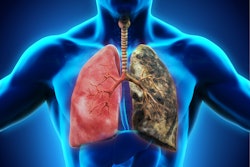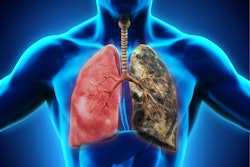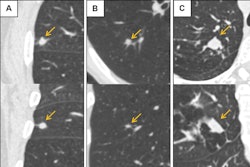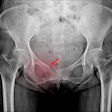A commercially available AI-based computer-aided detection (CAD) tool appears effective as a prescreener in low-dose CT lung cancer screening, according to an article published April 16 in the American Journal of Roentgenology.
The finding is from an experiment that tested the impact of the software in three scenarios, as a prescreener, an assistant, or as a backup for radiologists, noted first author Meesun Lee, MD, of Seoul National University Hospital in South Korea, and colleagues.
“Among scenarios, only AI as a pre-screener demonstrated higher net benefit than interpretation without AI,” the group wrote.
The use of low-dose chest CT (LDCT) for lung cancer screening in high-risk individuals is supported by evidence from multiple clinical trials showing an associated reduction in lung cancer mortality, the authors explained. Although AI is predominantly used to assist radiologists in interpreting images, its use in alternate scenarios warrant consideration, they noted.
Hence, in this study, the researchers evaluated the impact of different AI use scenarios on diagnostic outcomes and interpretation times for LDCT lung cancer screening in a real-world lung cancer screening population. The software (LuCAS-Plus, Monitor Corporation, South Korea) receives a single LDCT exam as input and then displays the location of detected nodules as an overlay on the images, as well as provides a density, size, and Lung-RADS category for each detected nodule. The system does not provide a probability score for nodule detection or likelihood of malignancy, the researchers noted.
The cohort included 366 individuals (358 male, 8 female; mean age, 64) who underwent LDCT from May 2017 to December 2017 as part of an earlier prospective lung cancer screening trial. Exams were interpreted by one of five readers, who reviewed cases in two sessions with and without the AI.
The researchers then reconstructed three simulated AI use scenarios: as an assistant, where radiologists interpreted all exams with AI assistance; as a prescreener, where radiologists only interpreted exams with a positive AI result; and as a backup, where radiologists reinterpreted exams when the AI suggested a missed finding.
Using AI as an assistant significantly increased the mean number of nodules identified per examination, yet did not provide a significant difference in sensitivity for classifying findings as Lung-RADS ≥ 3 (no nodules or benign nodules), according to the findings. In addition, there was no significant difference in this use in mean interpretation times with or without AI (161 vs. 164 seconds).
With AI as a prescreener, radiologists would avoid interpretation in 15.3% of the exams, the researchers noted. This scenario also significantly decreased mean interpretation times (143 seconds) without resulting in a significant difference in sensitivity for nodules classified as Lung-RADS category ≥ 3.
Finally, with AI as a backup tool, AI assigned a higher Lung-RADS category than the interpreting radiologist in 38.8% of examinations, prompting reinterpretations. However, the sensitivity for nodules classified as Lung-RADS category ≥ 3 was significantly higher in this scenario and resulted in significantly longer interpretation times.
“The simulation of various AI utilization scenarios for interpretation of LDCT screening examinations produced diverse results with respect to diagnostic outcomes and interpretation efficiency,” the group wrote.
Ultimately, the findings suggest that the use of AI as a pre-screener could help reduce workloads for radiologists for lung nodule detection without compromising the sensitivity for clinically actionable nodules, the group wrote. Importantly, this could reduce the high volume of exams and perhaps radiologist burnout, they added.
“An approach whereby radiologists only interpret LDCT examinations with a positive AI result can reduce radiologists' workload while preserving sensitivity,” the researchers concluded.



















